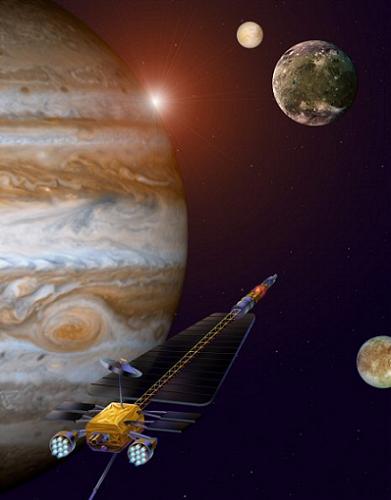NASA has chosen Northrop Grumman: Space Technologies (Northrop Grumman) as the company that will build the spacecraft Prometheus - JIMO-Jupiter Icy Moons Orbiter
Ariel Eisenhandler

NASA has chosen Northrop Grumman: Space Technologies (Northrop Grumman) as the company that will build the spaceship Prometheus (a Titan from Greek mythology, who discovered fire to humans and was punished by the gods for it, as well as the name of one of Saturn's moons) - a hyphen for the frozen moons of Jupiter (JIMO-Jupiter Icy Moons Orbiter)- and awarded them a $400 million contract to cover costs until 2008. JIMO will use a nuclear-powered ion engine to enter orbits around each of Jupiter's icy moons: Callisto, Ganymede ( Ganymede) and Europa (Europa). When it enters orbit, the spacecraft will be able to examine each of the moons in great detail with a variety of instruments to try and understand their composition, their history and whether conditions for life could form on them.
NASA's Jet Propulsion Laboratory (JPL-Jet Propulsion Laboratory) in Pasadena, California has selected Northrop Grumman: Space Technologies of Redondo Beach, California as the joint design contractor for the proposed mission of the Prometheus spacecraft: Compass to the icy moons of Jupiter - JIMO . The contract provides approximately 400 million dollars, which should cover the work until mid-2008.
The Prometheus-JIMO mission is part of an ambitious mission to orbit and explore three planet-sized moons of Jupiter, which: Callisto, Ganymede, and Europa, may contain vast oceans beneath their icy surface. A nuclear reactor will enable the mission, which will be launched in the next decade.
JIMO will be NASA's first mission to use electric-nuclear propulsion, which will allow the spacecraft to circle each of the frozen worlds to conduct a comprehensive study of their composition, their history and their ability to support life.
In addition, the JIMO mission, in conjunction with the "Vision of Space Exploration", develops and demonstrates technologies and capabilities in direct support for the realization of the vision, which include space systems with electric-nuclear power and electric-nuclear propulsion systems.
Illustration, credit: NASA
"We assembled an exceptional team of professionals to take us to the next stage of the mission. Seeing the mission develop is rewarding and I'm sure we have a good team here to lead us forward," says John Casani, project manager for the JIMO mission at JPL.
Under the contract Northrop Grumman will work with a government team to complete the early design of the spacecraft. The work includes the development of hardware, software and the activity examination of the design of the non-nuclear part of the spacecraft, as well as the development of the interfaces of the spacecraft, the space reactor and scientific instruments. The contractors are responsible for integrating the technologies funded and provided by the government into the spacecraft. In addition, they are responsible for assembling, integrating and testing space systems in coordination with applicable government requirements. The government team will jointly design the spacecraft with the contractors. NASA will provide the launch vehicle. The Office of Nuclear Reactors of the US Navy, which belongs to the Department of Energy in Washington, will own and be responsible for the space reactor. The government team includes: the Jet Propulsion Laboratory (JPL); NASA's Ames Research Center in Moffett Field, California; Glenn Research Center in Cleveland; the Kennedy Space Center in Florida (John F. Kennedy Space Center); The Langley Research Center in Hampton, Virginia and the Marshall Space Flight Center in Huntsville, Alabama. In addition, it includes the Office of Nuclear Power of the US Navy, which includes the Knolls Nuclear Power Laboratory in Schenectady, New York; Bettis Laboratories, Pittsburgh. The team also includes the Department of Energy's national laboratories that provide support.
The mission's instruments will be purchased competitively through an "Opportunity Announcement" from NASA. Three concurrent issues, identified by NASA's authorized science definition team, drive the proposed JIMO investigations:
1. To estimate the extent of subsurface oceans existing on the moons.
2. Learning the chemical composition of the moons, including organic substances and processes on the surface that affect them.
3. Carefully examine the entire Jupiter system and in particular the interrelationships between Jupiter and the atmospheres and surfaces of the moons.
JIMO is managed by JPL and is part of the Prometheus program - a program that examines a series of initiatives to develop power systems and technologies for space exploration inspired by the "Vision of Space Exploration". JPL, a division of the California Institute of Technology, manages the proposed JIMO mission for NASA's Exploration Systems Mission Directorate in Washington.
For more information about the mission or NASA visit the following websites:
Prometheus page on the NASA website
JIMO page on the Jet Propulsion Laboratory website
To the original message from NASA
https://www.hayadan.org.il/BuildaGate4/general2/data_card.php?Cat=~~~971418109~~~19&SiteName=hayadan
